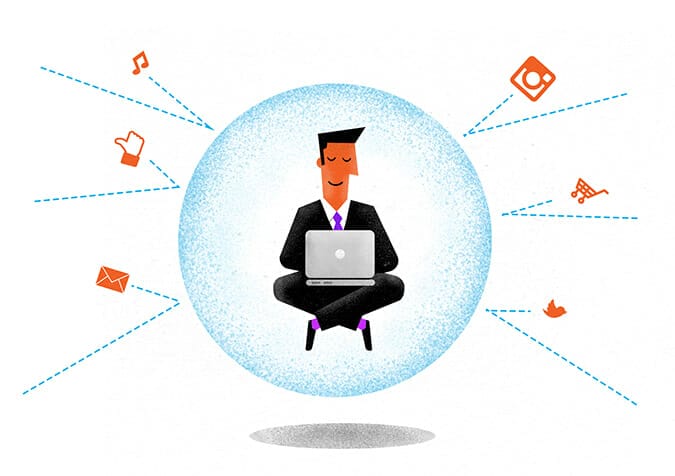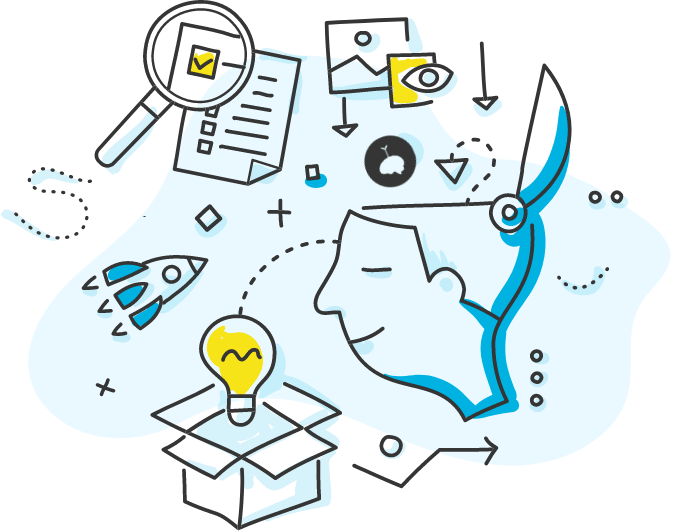Estimated Reading Time: 5 minutes, 16s.

In any one day, we alternate between two types of work. Knowing how to identify which type of work you’re doing is perhaps the most important thing you can keep in mind as you go about your day.
The first type of work is collaborative work. This work involves interacting with other people, and being available in case you’re needed. The higher the availability of you and your colleagues, the more productive your team will be.
The second type of work is focus work. This work benefits from all the attention you can dedicate to it. The less you’re distracted, the deeper you’re able to focus, and the more productive you become. This type of work benefits from hyperfocus—”deep work,” as author Cal Newport puts it.
The breakdown of collaborative and focus work is unique to your job. For example, a writer’s day might involve 90% focus work, and 10% collaborative work. If you’re an admin assistant, your workday may be the opposite, and require 10% focus work, and 90% collaborative work. If you’re a hardware engineer, your breakdown may be split in the middle.
It’s important to keep in mind what type of work you’re doing in any one moment. For focus work, we should defend our attention by disabling distractions ahead of time, and form an intention to concentrate on something important. For collaborative work, we simply need to be connected and available. But here’s the thing: while collaboration comes pretty effortlessly, we usually have to block off time to focus.
In last week’s article, I wrote about my conversation with Dr. Mary Czerwinski, Microsoft’s principal researcher for multitasking and focus (among other topics). When I asked what one thing from her research has changed the way she works, she mentioned reserving time to focus. Most of Mary’s work day is spent collaborating with other people—she manages a team of researchers. With her time skewered more towards collaborative work, she considers it essential to defend her focus time. Most days she ensures she has time to scatter her attention by blocking off a two-hour chunk of time, with a walking break in the middle.
I also had the chance to chat with Natalie McCullough, Microsoft’s General Manager for MyAnalytics and Workplace Analytics. MyAnalytics is a product I find absolutely fascinating: it’s like Fitbit, but instead of tracking your physical activity, it tracks your digital activity, analyzing and nudging you to work in a more productive way. With MyAnalytics, I truly believe Microsoft has created the best personal productivity software out there. MyAnalytics is only available for corporate enterprises right now, so most of us don’t have access (yet).1
The MyAnalytics app works by crunching data on how you use email and your calendar (on top of other things), offering fascinating insights into your productivity—including your collaborative and focus work rhythms. Other insights include:
- How many weekly hours you spend doing focused work;
- How quickly you reply to email (and how quickly your coworkers reply in return);
- How quickly you respond to your manager’s emails (and how quickly they respond to you);
- How many hours you spend on email each week;
- Who you collaborate with the most during the week;
- How frequently you multitask during meetings;
- How much time you spend working after hours.
I primarily use Gmail as my email provider—but if MyAnalytics was available for people outside large companies, it would be enough to convince me to switch to Outlook. Becoming more aware of your work patterns is fascinating, but not the only reason I’d make the switch. I’d also do it for the nudges MyAnalytics provides: throughout the week, the app offers suggestions for exactly what you should do to become more productive.
It will give you a heads up about:
- The recurring meetings in which you multitask;
- When you’re spending too much time on email;
- When you haven’t spoken with someone in a while and should consider reconnecting;
- And much more.
If you’re a manager, it’ll even tell you how the emails you send after hours affect the number of after-work hours logged by your team.
Getting back to the theme of this article, Natalie says one of the most powerful nudges MyAnalytics has is one encouraging focus time. In fact, she thinks this is the most valuable nudge the app has to offer. For example, the app will alert you when your calendar is filling up, and suggest you block off some focus time. “One of the hardest things for knowledge workers today is not being interruption-driven, and allowing ourselves to do deep cognitive work,” says Natalie.
I’m fascinated by the real, juicy data collected by Natalie’s team. This includes anonymized data from tens of thousands of large company teams, analyzing what separates the most productive workers from the least productive ones.2 They’ve discovered some fascinating insights using this data:3
- For every extra hour a manager works, their team members work an additional 20 after-hour minutes;
- Managers who multitask in meetings are 2.2 times more likely to have employees who do the same;
- Employees who get double the number of one-on-one meetings with their manager are 67% less likely to be disengaged.
The team has also used this data to uncover the power and importance of focus time. Natalie says her data shows that “the average worker inside of a company spends many, many hours a week or a day in fruitless collaboration that is not effective, and is actually dispirited.” Getting enough focus time is the antidote.
Your most productive day will always involve a combination of collaborative and focus work. While collaborative work happens relatively naturally, we need to schedule time to focus. Channel the MyAnalytics app, and keep your rhythms in mind as you work, noting when you’re able to focus most deeply. Block off that time, tame distractions in advance, and make room in your schedule to focus. In the push to become more productive, this time is invaluable.
Full disclosure: Microsoft paid my way to attend The New York Times New Work Summit, a conference about the future of work. They did not pay me to write this post.
Illustration by Sinisa Sumina.
I tried to get Natalie to divulge whether the product would be available in the future for non-corporate types like entrepreneurs and students, but she couldn’t yet reveal anything. ↩
Sources: What Great Managers Do Daily; If You Multitask During Meetings, Your Team Will, Too ↩




